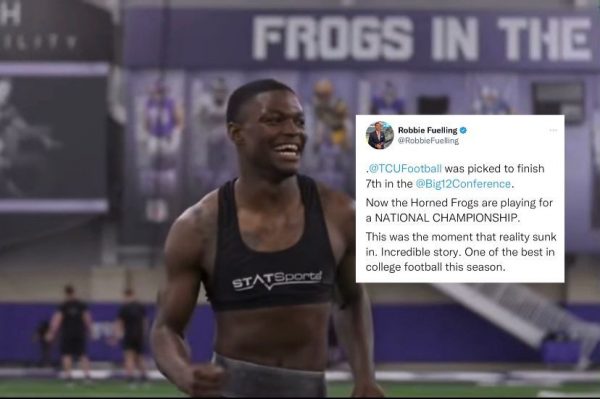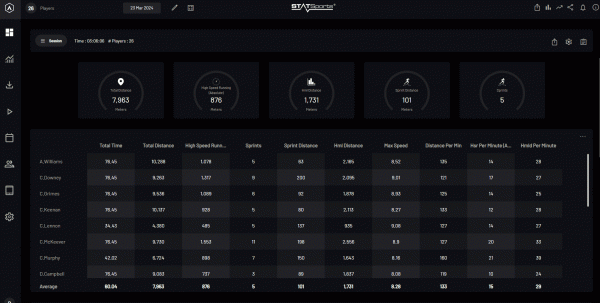
11 Apr TCU’s Tyrell Brown: Translating Game Speed During Spring Ball
Tyrell Brown is Assistant Director of Human Performance for football at Texas Christian University, the 2023 NCAA Football Championship finalists.
Brown develops and implements training programs that include speed, agility conditioning, strength training, injury prevention, prehab and flexibility, using STATSports GPS technology to inform those programs. He also assists with sports psychology and lifestyle presentations for student-athletes.
We spoke to Tyrell during Spring Training in Texas to see how preparation for TCU’s upcoming season was going, and to learn more on what makes this part of the season so important from a physical point of view.

In terms of overall athletic performance, what are you looking to achieve over a period like Spring ball? Is there more of a focus on the weight room or are you looking to make speed gains on the field?
Spring ball is about optimizing the strength gains that have been obtained during winter training.
It is allowing for that to transfer into on-field success through new movement patterns and strategies.
While on the field, you can continue to develop high-quality sprint mechanics that can be implemented during practice.
How does GPS monitoring play a role in that work developing your athletes on the field? Is it about optimizing performance, driving competition, increasing player availability, etc?
During this time GPS monitoring allows me to identify if we are translating “game speed”.
What you would want to see is that guys who were consistently hitting higher speeds in training, are maintaining that higher speed during loaded running and sport.
It’s not good just to be fast in winter training. You have to be competitively fast on the field and in front of your coaches, while still maintaining availability during this time of the year.
By implementing the STATSports Threshold feature on Sonra, available across the Desktop, iPad Live & Apple Watch Live Applications, practitioners can use a customisable colour coded traffic light system to easily identify player performance across the entire STATSports metric suite.
By setting their desired threshold bands, when using the STATSports live products coaches can use this visual information whilst on the field with their players to inform their practice and maximise the time spent coaching.
The threshold for the speed zone of 87% Maximum Speed can be set so a particular colour is displayed once it is achieved. Thresholds can also be set for the number of efforts in this zone, and the distance covered in this zone.

If you were to pick one KPI metric to focus on when analyzing GPS data what would it be, and how does this metric inform your training and recovery strategies?
The KPI metric I’d focus on would be 87%+ sprint effort and distance. This would show our repeat sprint ability at high speeds and if we are able to perform those efforts for a longer amount of time.
By using these in combination it would allow us to identify their ability to translate winter training speed potential and optimize their training stimulus going forward.
By utilizing STATSports’ fully customisable speed zones, practitioners can set speed zones that are relative to a player’s maximum speed, making it extremely easy for coaches to identify the 87%+ speed exposures across their whole squad.
Additionally, the distance covered in these relative speed zones can also be analysed at the click of a button allowing both the effort count and volume of sprints to be accounted for in player monitoring. This can also be achieved by setting the players sprint entry speed to 87%, dependent on user preference.

In terms of athletic development, how do you split out training strategies for the ‘fast’ guys and the ‘big’ guys?
The training strategies for “fast” athletes (i.e., Receivers/Defensive Backs) and “big” guys (i.e., Offensive Lineman and Defensive Lineman) differentiate based on the needs of the position.
For your “fast” athletes we would want to stress more athletic movements and functional strength for the lower body incorporating higher intensities while lowering volume.
For example, power cleans, back squats, split squats, RDL, and Nordic hamstring curls.
The “big” guys main priority would be maintaining strength, and power to keep them sturdy throughout the point of contact.
Higher volume accessory movements, specifically post-chain exercises, would assist with their priority.
For example, reverse hypers, good mornings, leg curls, hammer back row, and lat pull downs.
Do you ever look at other sports, in terms of what their practitioners are doing, for inspiration or knowledge on bringing new sports science or S&C methodologies to football?
Yes, I look at other sports practitioners to see what they are doing to better my knowledge for implementation.
Two examples are proper mechanics of sprint training for Track and Field athletes, and then Powerlifting / Olympic lifting for principles and proper technique in the weight room.
A look ahead to the 2024 College Football Season
With one eye on the season ahead and the other on the welfare of players, coaches view pre-season as an opportunity to home in on their tactics and ensure players reach their full physical potential.
Through the incorporation of the STATSports Sonra product suite, coaches can rely on accurate objective data to inform their daily decision making.
This is the second episode in our series of College Football Spring Training Q&As, following on from New Mexico State Football’s Eric Klein interview last week. You can read that one here.
If you are a college or high school football coach, look no further than the industry’s leading wearable technology. Sign up for a demo here.